Comparison of Flows through a Tidal Inlet in Late Spring and after the Passage of an Atmospheric Cold Front in Winter Using Acoustic Doppler Profilers and Vessel-Based Observations
Abstract
:1. Introduction
2. Materials and Methods
3. Results
3.1. Tidal and Subtidal Flows in Winter
3.2. Tidal and Subtidal Flows in Spring
3.3. Hydrological Features during Observations
4. Discussion
4.1. The Influence of Wind vs. Tidal Cycle
4.2. Tidal Straining
5. Concluding Remarks
- (1)
- In microtidal systems such as Barataria Bay, the impact of weather is more important than that of the tidally driven flow (the temporally averaged currents induced by tides), especially in winter;
- (2)
- In this region, the winter weather is very different compared to late spring and summer weather —it is dominated by atmospheric cold front passages at 3–7 day intervals, which keeps the water column vertically well mixed and the water level oscillation and related flushing of the bays enhanced;
- (3)
- The winter and late spring flow structures are consistent with the wind conditions in these seasons, with net outflow in winter forced by strong northerly winds and a two-layered flow structure in late spring, with inflow in shallow water and the upper layer caused by weak–medium southeasterly winds and outflow in deep water by the pressure gradient force;
- (4)
- The vertical structure of salinity in the central BP pass confirms an inverse estuarine condition in late spring; the stratification is strongest at the flood slack when fresher coastal water occupies the upper water layer and diminishes as the coastal water retreats;
- (5)
- The low-salinity coastal water may flow into the bay in late spring; the southeasterly wind in late spring drives the coastal water, which is diluted by the Mississippi River discharge due to spring flooding, into the eastern end of the BP and spreads westward in the channel, whereas the northerly wind after cold front passage in winter impedes coastal water from entering the bay;
- (6)
- As far as vessel-based transect surveys are concerned, this work complements previous studies in this area, which only focused on summer conditions across the transect (except moored observations at fixed locations and numerical experiments). This work shows that the winter and late spring conditions have certain similarities: the along-channel transport responds to weather conditions; and diurnal velocity amplitudes decrease with water depth.
Author Contributions
Funding
Institutional Review Board Statement
Informed Consent Statement
Data Availability Statement
Acknowledgments
Conflicts of Interest
References
- Baker, R.C. Flow Measurement Handbook—Industrial Designs, Operating Principles, Performance, and Applications; Cambridge University Press: New York, NY, USA, 2000; p. 524. [Google Scholar]
- Spitzer, D.W. Industrial Flow Measurement, 3rd ed; ISA—The Instrumentation, Systems, and Automation Society: Triangle Park, NC, USA, 2005; p. 426. [Google Scholar]
- Anklin, M.; Drahm, W.; Rieder, A. Coriolis mass flowmeters: Overview of the current state of the art and latest research. Flow Meas. Instrum. 2006, 17, 317–323. [Google Scholar] [CrossRef]
- Rivas, A.L. Current-meter observations in the Argentine Continental Shelf. Cont. Shelf Res. 1997, 17, 391–406. [Google Scholar] [CrossRef]
- Howarth, M.J. Intercomparison of AMF VACM and Aanderaa current meters moored in fast tidal currents. Deep Sea Res. Part A Oceanogr. Res. Pap. 1981, 28, 601–607. [Google Scholar] [CrossRef]
- Johnson, W.R.; Royer, T.C. A comparison of two current meters on a surface mooring. Deep Sea Res. Part A Oceanogr. Res. Pap. 1986, 33, 1127–1138. [Google Scholar] [CrossRef]
- Wong, K.-C. On the wind-induced exchange between Indian River Bay, Delaware and the adjacent continental shelf. Cont. Shelf Res. 2002, 22, 1651–1668. [Google Scholar] [CrossRef]
- Teledyne, R.D. Instruments. In Acoustic Doppler Current Profiler Principles of Operation a Practical Primer; Teledyne, R.D., Ed.; Instruments: Poway, CA, USA, 2011; p. 56. [Google Scholar]
- Kantha, L. Barotropic Tides in the Gulf of Mexico. In Circulation in the Gulf of Mexico: Observations and Models; AGU: Washington, DC, USA, 2005; Volume 161, pp. 159–163. [Google Scholar]
- Patrick, W.H.J.; Delaune, R.D. Nitrogen and phosphorus utilization by spartina alterniflora in a salt marsh in Barataria Bay, Louisiana. Estuar. Coast. Mar. Sci. 1976, 4, 9–64. [Google Scholar] [CrossRef]
- Bianchi, T.S.; Robert, L.C.; Perdue, E.M.; Kolic, P.E.; Green, N.; Zhang, Y.; Smith, R.W.; Kolker, A.S.; Ameen, A.; King, G.; et al. Impacts of diverted freshwater on dissolved organic matter and microbial communities in Barataria Bay, Louisiana, U. S.A. Mar. Environ. Res. 2011, 72, 248–257. [Google Scholar] [CrossRef]
- Li, C.; White, J.R.; Chen, C.; Lin, H.; Weeks, E.; Galvan, K.; Bargu, S. Summertime tidal flushing of Barataria Bay: Transports of water and suspended sediments. J. Geophys. Res. Oceans 2011, 116, 1–15. [Google Scholar] [CrossRef]
- Li, C.; Huang, W.; Milan, B. Atmospheric cold front-induced exchange flows through a microtidal multi-inlet bay: Analysis using multiple horizontal ADCPs and FVCOM simulations. J. Atmos. Ocean Tech. 2019, 36, 443–472. [Google Scholar] [CrossRef]
- Georgiou, I.Y.; FitzGerald, D.M.; Stone, G.W. The impact of physical processes along the Louisiana coast. J. Coast. Res. 2005, 44, 72–89. [Google Scholar]
- Snedden, G. River, Tidal and Wind Interactions in a Deltaic Estuarine System. Ph.D. Thesis, Louisiana State University, Baton Rouge, LA, USA, 2006. [Google Scholar]
- Cui, L. Tidal-, Wind-, and Buoyancy-Driven Dynamics in the Barataria Estuary and Its Impact on Estuarine-Shelf Exchange Processes. Ph.D. Thesis, Louisiana State University, Baton Rouge, LA, USA, 2018. [Google Scholar]
- Kjerfve, B.; Stevenson, L.H.; Proehl, J.A.; Chrzanowski, T.H.; Kitchens, W.M. Estimation of material fluxes in an estuarine cross section: A critical analysis of spatial measurement density and errors. Limnol. Oceanogr. 1981, 26, 325–335. [Google Scholar] [CrossRef]
- Kjerfve, B. Circulation and salt flux in a well mixed estuary. In Physics of Shallow Estuaries and Bays, Coastal Estuarine Study; van de Kreeke, J., Ed.; Springer: New York, NY, USA, 1986; Volume 16, pp. 22–29. [Google Scholar]
- Lwiza, K.M.M.; Bowers, D.G.; Simpson, J.H. Residual and tidal flow at a tidal mixing front in the North Sea. Cont. Shelf Res. 1991, 11, 1379–1395. [Google Scholar] [CrossRef]
- Ca’ceres, M.; Valle-Levinson, A.; Atkinson, L. Observations of cross-channel structure of flow in an energetic tidal channel. J. Geophys. Res. 2003, 108, 3114. [Google Scholar] [CrossRef]
- Wang, Y.; Gao, S. ADCP measurements of suspended sediment flux at the entrance to Jiaozhou Bay, western Yellow Sea. Acta Oceanol. Sin. 2013, 32, 96–103. [Google Scholar] [CrossRef]
- Valle-Levinson, A.; Schettini, C.A.F. Fortnightly switching of residual flow drivers in a tropical semiarid estuary. Estuar. Coast. Shelf Sci. 2016, 169, 46–55. [Google Scholar] [CrossRef]
- Feng, Z.; Li, C. Cold-front-induced flushing of the Louisiana Bays. J. Mar. Syst. 2010, 82, 252–264. [Google Scholar] [CrossRef]
- CO-OPS Data. Available online: https://tidesandcurrents.noaa.gov/stationhome.html?id=8761724 (accessed on 1 May 2020).
- GHCN Data. Available online: https://www.ncdc.noaa.gov/cdo-web/datasets/GHCND/stations/GHCND:USW00012916/detail (accessed on 1 May 2020).
- Emery, W.J.; Thomson, R.E. Data Analysis Methods in Physical Oceanography, 2nd ed.; Elsevier: Amsterdam, The Netherlands, 2004; 654p. [Google Scholar]
- Li, C.; Huang, W.; Chen, C.; Lin, H. Flow regimes and adjustment to wind-driven motions in Lake Pontchartrain estuary: A modeling experiment using FVCOM. J. Geophys. Res. Oceans 2018, 123, 8460–8488. [Google Scholar] [CrossRef]
- Cheng, R.T.; Powell, T.M.; Dillon, T.M. Numerical models of wind-driven circulation in lakes, Appl. Math. Model. 1976, 1, 141–159. [Google Scholar] [CrossRef]
- Csanady, G.T. Circulation in the coastal ocean. Adv. Geophys. 1982, 23, 101–184. [Google Scholar]
- Engelund, F. Steady wind set-up in prismatic lakes, reprinted in environmental hydraulics: Stratified flows. In Lecture Notes on Coastal and Estuarine Studies; Pedersen, F.B., Ed.; Springer: New York, NY, USA, 1986; Volume 18, pp. 205–212. [Google Scholar]
- Fischer, H.B. Mixing and dispersion in estuaries, Ann. Rev. Fluid Mech. 1976, 8, 107–133. [Google Scholar] [CrossRef]
- Gibbs, M.; Abell, J.; Hamilton, D. Wind forced circulation and sediment disturbance in a temperate lake. N. Z. J. Mar. Freshw. Res. 2016, 50, 209–227. [Google Scholar] [CrossRef]
- Lin, J.; Li, C.; Boswell, K.M.; Kimball, M.; Rozas, L. Examination of Winter Circulation in a Northern Gulf of Mexico Estuary. Estuaries. Coast. 2016, 39, 1–21. [Google Scholar] [CrossRef]
- Li, C. 3D analytic model for testing numerical tidal models. J. Hydraulic. Eng. 2001, 127, 709–717. [Google Scholar] [CrossRef]
- Weather map. Available online: https://www.wpc.ncep.noaa.gov/dwm/dwm.shtml (accessed on 1 May 2020).
- Juarez, B.; Valle-Levinson, A.; Li, C. Estuarine salt-plug induced by a freshwater pulse from the inner shelf. Estuar. Coast. Shelf Sci. 2020, 232, 106491. [Google Scholar] [CrossRef]
- Li, C.; Swenson, E.; Weeks, E.; White, J.R. Asymmetric tidal straining across an inlet: Lateral inversion and variability over a tidal cycle. Estuar. Coast. Shelf Sci. 2009, 85, 651–660. [Google Scholar] [CrossRef]
- Simpson, J.H.; Brown, J.; Matthews, J.; Allen, G. Tidal straining, density currents, and stirring in the control of estuarine stratification. Estuaries 1990, 13, 125–132. [Google Scholar] [CrossRef]
- Simpson, J.H.; Williams, E.; Brasseur, L.H.; Brubaker, J.M. The impact of tidal straining on the cycle of turbulence in a partially stratified estuary. Cont. Shelf. Res. 2005, 25, 51–64. [Google Scholar] [CrossRef]
- Liu, Y.; Sun, C.; Gong, Z.; Li, J.; Shi, Z. Multidecadal seesaw in cold wave frequency between central Eurasia and Greenland and its relation to the Atlantic Multidecadal Oscillation. Clim. Dyn. 2022, 58, 1403–1418. [Google Scholar] [CrossRef]
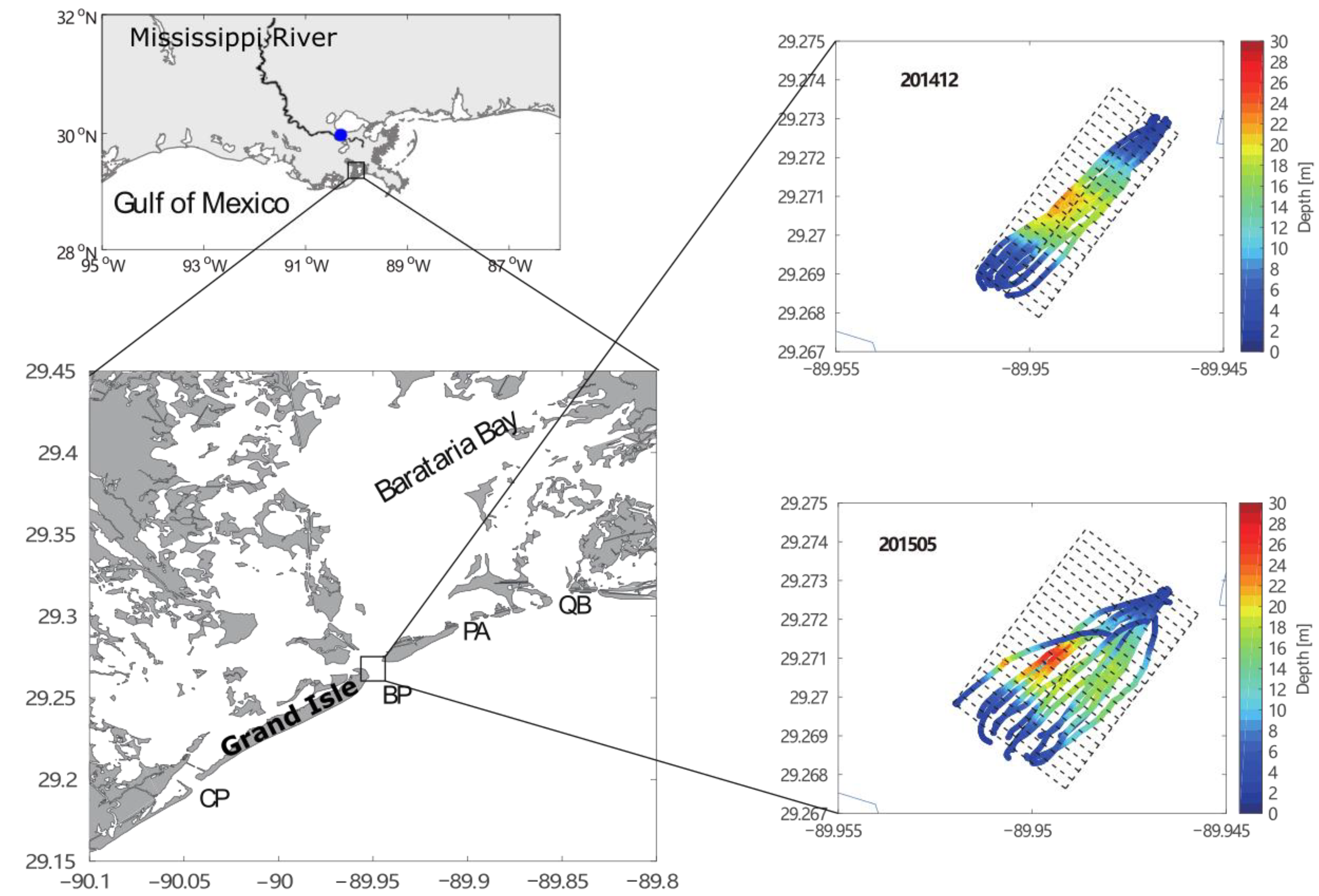
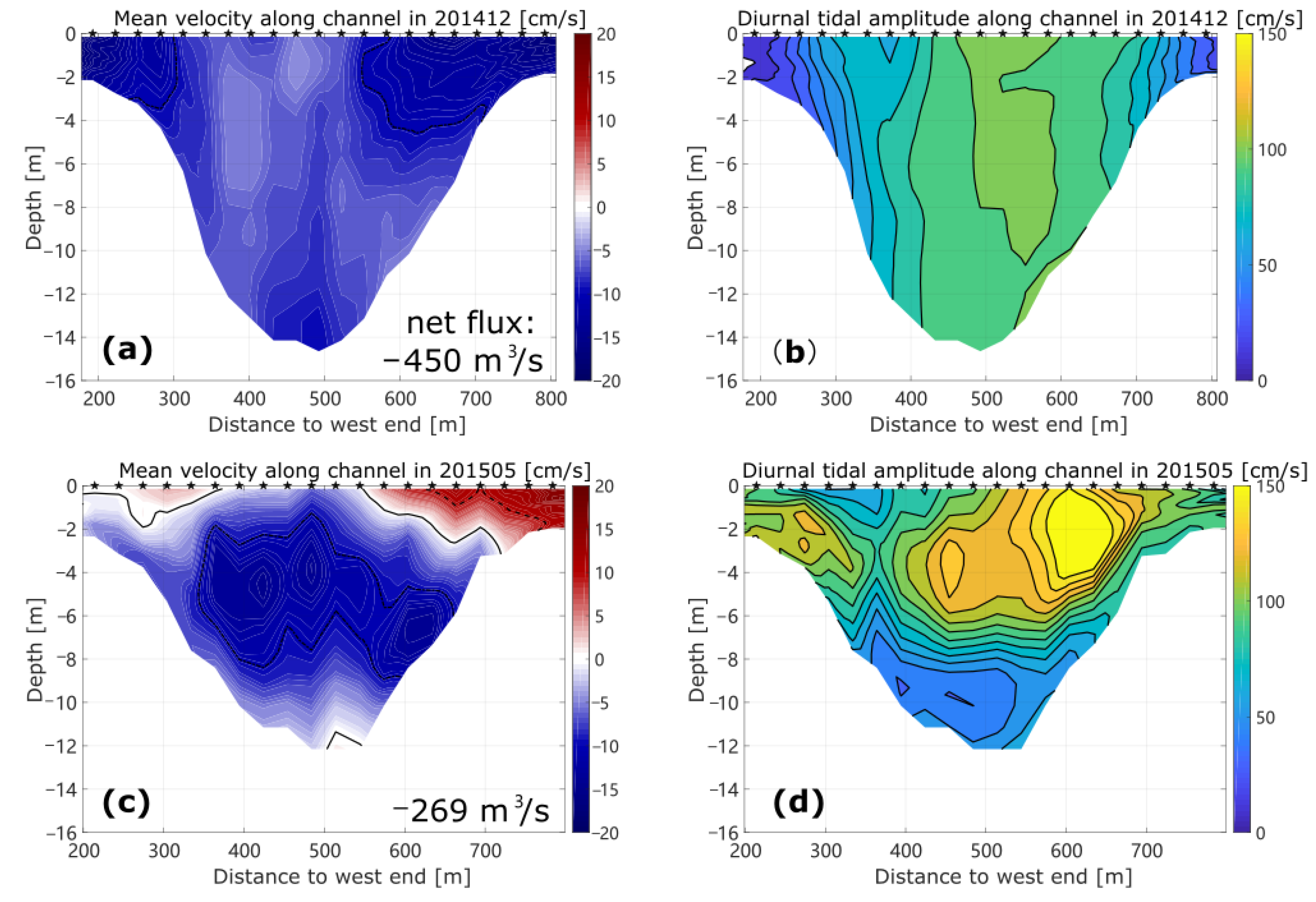

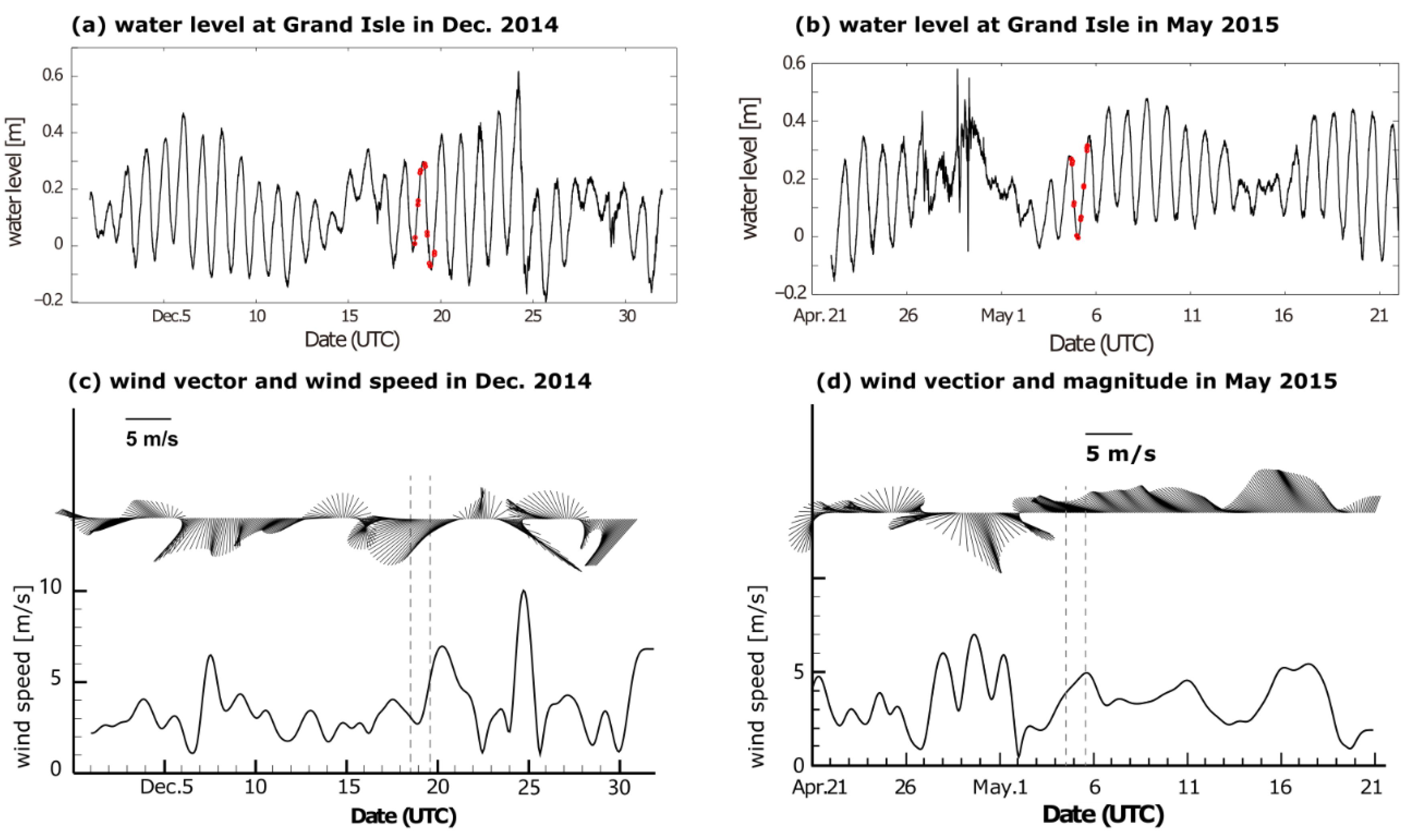
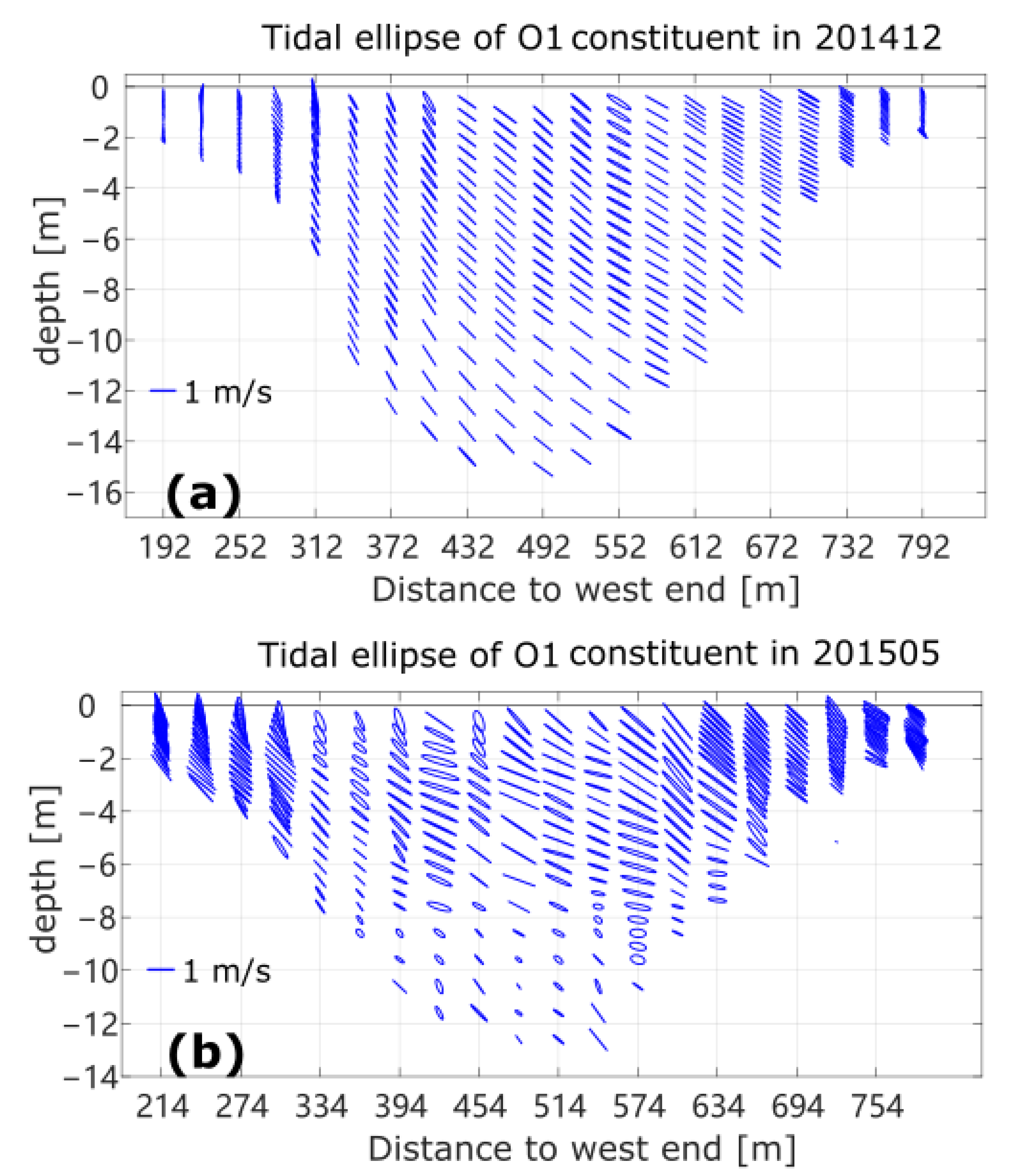
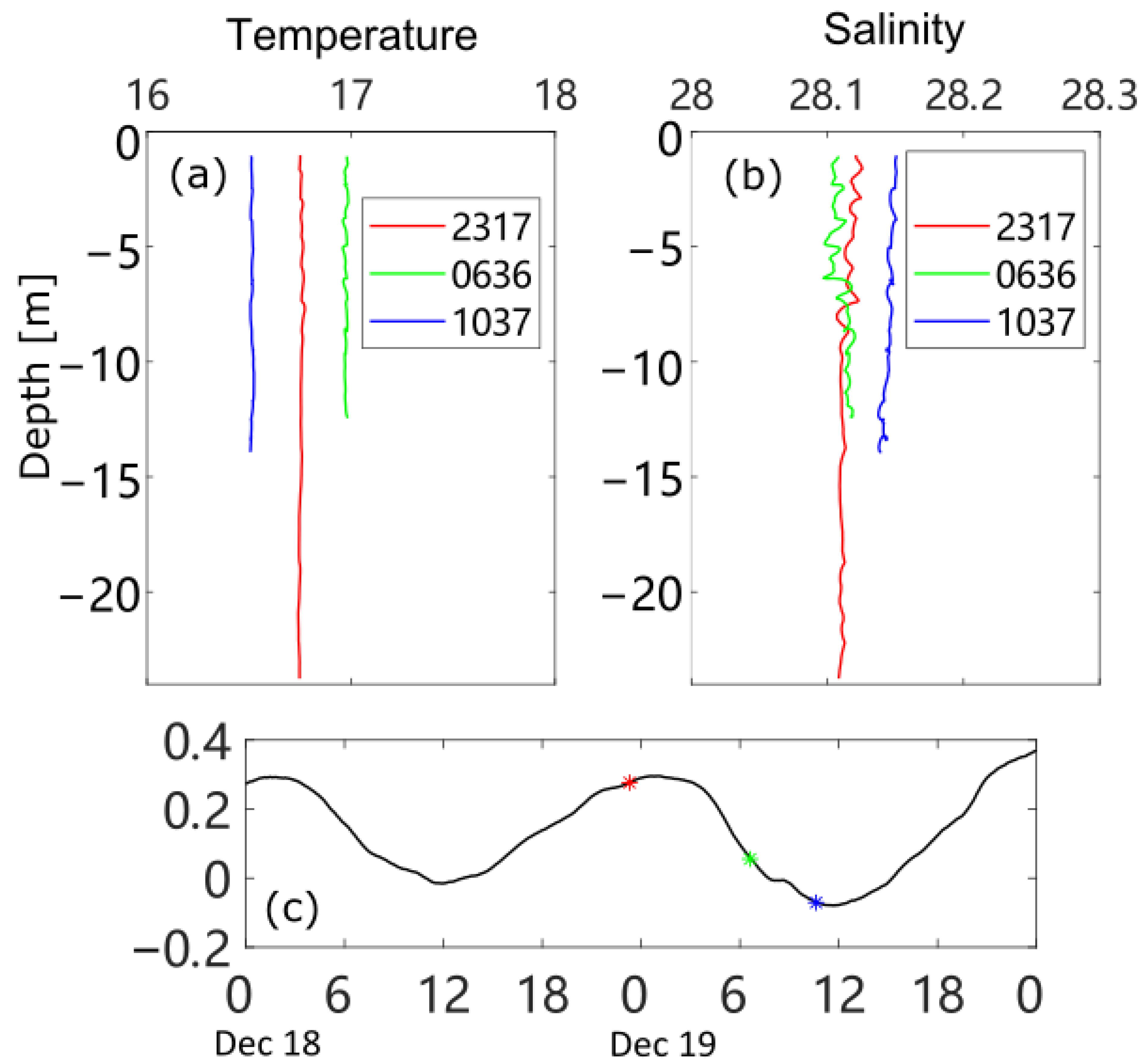

Publisher’s Note: MDPI stays neutral with regard to jurisdictional claims in published maps and institutional affiliations. |
© 2022 by the authors. Licensee MDPI, Basel, Switzerland. This article is an open access article distributed under the terms and conditions of the Creative Commons Attribution (CC BY) license (https://creativecommons.org/licenses/by/4.0/).
Share and Cite
Li, M.; Li, C. Comparison of Flows through a Tidal Inlet in Late Spring and after the Passage of an Atmospheric Cold Front in Winter Using Acoustic Doppler Profilers and Vessel-Based Observations. Sensors 2022, 22, 3478. https://doi.org/10.3390/s22093478
Li M, Li C. Comparison of Flows through a Tidal Inlet in Late Spring and after the Passage of an Atmospheric Cold Front in Winter Using Acoustic Doppler Profilers and Vessel-Based Observations. Sensors. 2022; 22(9):3478. https://doi.org/10.3390/s22093478
Chicago/Turabian StyleLi, Mingming, and Chunyan Li. 2022. "Comparison of Flows through a Tidal Inlet in Late Spring and after the Passage of an Atmospheric Cold Front in Winter Using Acoustic Doppler Profilers and Vessel-Based Observations" Sensors 22, no. 9: 3478. https://doi.org/10.3390/s22093478
APA StyleLi, M., & Li, C. (2022). Comparison of Flows through a Tidal Inlet in Late Spring and after the Passage of an Atmospheric Cold Front in Winter Using Acoustic Doppler Profilers and Vessel-Based Observations. Sensors, 22(9), 3478. https://doi.org/10.3390/s22093478






